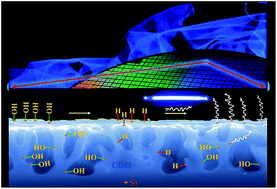A method to derivatize surface silanol groups to Si-alkyl groups in carbon-doped silicon oxides†
Abstract
A carbon-doped silicon oxide (CDO) finds use as a material with a low dielectric constant (k) for copper interconnects in multilayered integrated circuits (ICs). Hydrophilic silanol groups (Si–OH) on its surface, however, can attract moisture, thereby causing an undesirable increase in the dielectric constant. Modification of the exposed hydrophilic surface to a hydrophobic functional group provides one solution to this problem. We report here a strategy for converting surface Si–OH to hydrophobic silicon hydride (Si–H) without affecting the internal oxide network in CDO. The approach involves esterification of the exposed silanol to its triflate (silyltrifluoromethanesulfonate, Si–O–Tf), followed by reduction to Si–H with diisobutylaluminum hydride. Si–H is further modified by a photochemical reaction with an alkene (1-octadecene) to yield Si–R (R = –C18H37) to provide a more moisture resistant, and less polar Si–C as opposed to the Si–O backbone. Fourier transform infrared (FT-IR) spectroscopy, X-ray photoelectron spectrometry (XPS), and measurements of the contact angle with water substantiated the successful conversion. The reaction scheme is versatile, transforming silanol groups to silicon hydride in widely varying chemical sites, from small molecules to the surfaces of silica gels, SiOx and CDO wafers. A comparison with the films (self-assembled monolayers) derivatized with the octadecyltrichlorosilane indicated that the new method leads to a thicker (≈5 nm) but more loosely packed hydrocarbon film with slightly lower contact angles.


 Please wait while we load your content...
Please wait while we load your content...